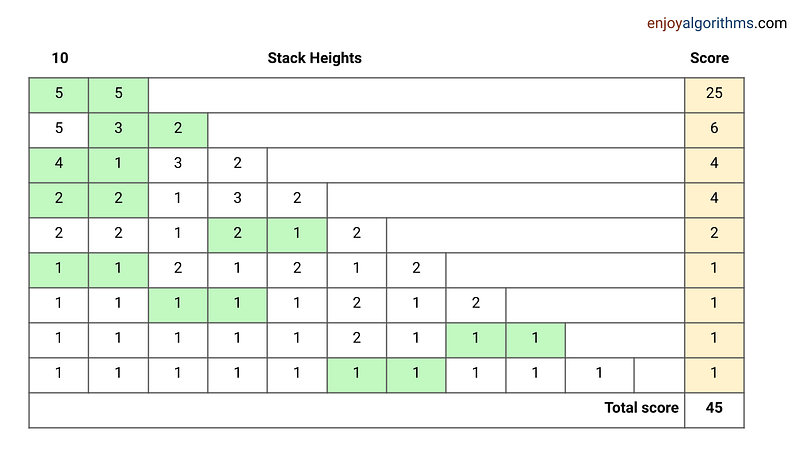You have given n-bulbs connected in a circle with a switch for each bulb. The connection is such that if you change the state of anyone bulb may be on or off, it will toggle the state of its adjacent bulbs. All the bulbs are initially switched off. You have to find the number of steps such that all the bulbs are switched on.
Box Unstacking Problem
Related tags:
algorithmic-puzzlesProblem Statement
You begin with a stack of n boxes. Then you make a sequence of moves. In each move, you divide one stack of boxes into two non-empty stacks. The game ends when you have n stacks, each containing a single box.
You earn points for each move. For example, if you divide one stack of heights A + B into two stacks of heights A and B, you will score AB points for that move. The overall score is the sum of the points that you earn for each move. (A sample example is given in the image below).
What strategy should you use to maximize your total score? For example, suppose we begin with a stack of n = 10 boxes. Here is one possible way to proceed with the game:

Here is the most interesting part! Prove that: Any strategy of unstacking n boxes will give a score of n(n − 1)/2 points. In other words: Prove that the overall score will depend entirely on the number of boxes, irrelevant to what strategy you choose.
Proof using induction
Suppose P(n) is the total points achieved after unstacking n boxes. Now we need to prove that P(n) = n(n − 1)/2. One idea is to use induction. In this case, we prove that base case P(1) is true and P(1), . . . , P(n − 1) imply P(n) for all n ≥ 2.
Base case
If n = 1, then there is only one box and no moves are possible. So total points = 1(1 − 1)/2 = 0 and P(1) is true.
Inductive steps
We have a stack of n boxes. In the first move, suppose we split n boxes into two substacks with sizes k and n − k (0< k < n). Now total points for the game is the sum of points for the first move plus points obtained by unstacking the two smaller substacks.
=> Total points for unstacking n boxes = (Points for 1st move) + (Points for unstacking k boxes) + (Points for unstacking n − k boxes)
- We are dividing n boxes into two substacks of size k and n — k. So total points for the 1st move = k(n − k).
- If P(n) is the point for unstacking n boxes, then points for unstacking k boxes = P(k), and Points for unstacking n − k boxes = P(n — k).
We put these values in the above equation:
=> P(n) = k(n − k) + P(k) + P(n — k)
Now for the inductive step, suppose P(1), P(2)… P(n — 2), P(n — 1) are true i.e. P(k) = k(k − 1)/2, where 0 < k < n. Now we need to prove that P(n) will be also true.
So based on the above assumption:
- P(k) = k(k − 1)/2
- P(n — k) = (n − k)(n − k − 1)/2
=> P(n) = k(n − k) + k(k − 1)/2 + (n − k)(n − k − 1)/2
= (2nk − 2k² + k² − k + n² − nk − n − nk + k² + k)/2
= n(n − 1)/2 (Several terms cancel out each other.)
So if P(1), P(2)… P(n — 2), and P(n — 1) are true, then P(n) is also true. Similarly, we can prove that P(n + 1) will be also true, if P(1), P(2), . . . P(n) are true. And so on!
A critical question to think: Instead of using induction, can we think of solving this recurrence [P(n) = k(n — k) + P(k) + P(n — k)] directly to obtain the value n(n — 1)/2? What challenges are associated with solving this recurrence?
Enjoy learning, enjoy mathematics!
More blogs to explore
There are 3 doors behind which are two goats and a car. You pick door 1 hoping for the car but don’t open it right away. Monty Hall, the game show host who knows what's behind the doors, opens door 3, which has a goat. Here's the game: do you want to pick door No. 2? Is it to your advantage to switch your choice?
There are n+1 people at a party. They might or might not know each other names. There is one celebrity in the group, and the celebrity does not know anyone by their name. However, all the n people know that celebrity by name. You are given the list of people present at the party. And we can ask only one question from each one of them. “Do you know this name”? How many maximum numbers of questions do you need to ask to identify the actual celebrity?